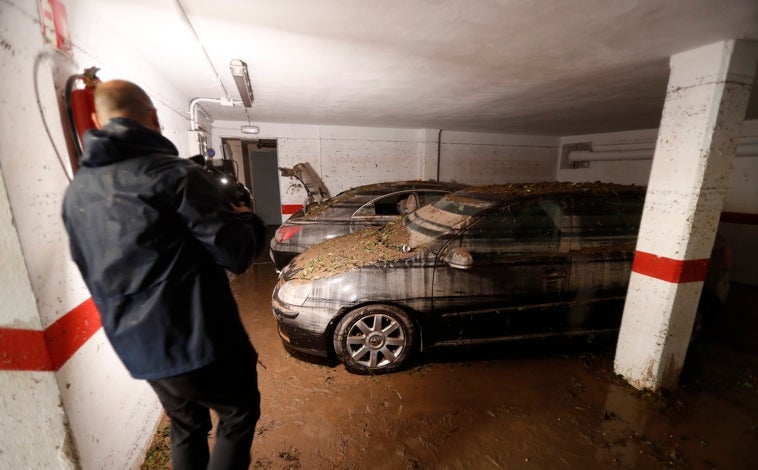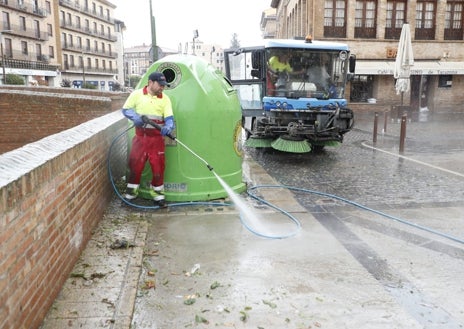"The worst part, as always, is for the fields. They were expecting a historic year, and the dana has wiped out 50% of the grain."

The flood warnings in Aragon since Wednesday, July 11, primarily affected the northwest of the province of Zaragoza , in municipalities of the Ribera Alta del Ebro and Moncayo . On Friday afternoon, the prelude to what was to come in the final hours, Tarazona took the brunt. The lower part of the town was flooded by a downpour that dumped between 50 and 60 liters per square meter in just one hour, according to the City Council. The extremely strong storm of rain and hail began at 7:00 p.m.
According to Diego Cobos , Councilor for Civil Protection and Citizen Security, speaking to ABC , the worst damage, despite up to 16 firefighters working all night to pump out water from basements, garages, and commercial premises, is going to be in the countryside. Hundreds of hectares of cereal crops were devastated in just twenty minutes by a hailstorm the size of "euro coins," Cobos says. They will consider requesting a declaration of a disaster area, he confirmed, as did Tono Jaray, the mayor of the municipality, in an initial assessment of the damage.
The mayor of Tarazona praised the "very rapid" intervention of the different institutions in responding to the damage caused by the passage of the dana through the Zaragoza town: "In ten minutes, when there were still no videos of what was happening, we were already in contact with the Emergency teams and they were already getting started from Zaragoza," he said, although he also acknowledged that they were surprised by the intensity and speed with which the huge downpour formed.



The Civil Protection councilor laments that farmers are seeing adverse weather conditions ruin their situation once again: "They were expecting a historic year for wheat and barley harvests; they were at 50% yield, after two very tough years of drought and shortages. Now the hail has wiped out everything" in this area, where they were preparing to harvest corn in just one week. Hundreds of fruit trees have also been devastated.
The urban cleanup required after the torrent of water, which blocked all drains and left numerous tree branches and some fallen roof tiles, was almost complete yesterday, Saturday, at noon when Jaray, along with the other mayors affected by the flood, participated in the meeting of the Integrated Operational Coordination Center (Cecopi) convened by the Aragonese government. The Minister of the Interior, Roberto Bermúdez de Castro, chaired the meeting and was accompanied by the Minister of Health, although the impact on healthcare was minimal except for some problems with the power supply in health areas and during the search for doctors.
Bermúdez de Castro stated at the conclusion of the Cecopi meeting that they had worked all night, with members of the Military Emergency Unit (UME) and 16 firefighters from the Provincial Council and Zaragoza City Council, to alleviate the dozens of incidents that were located in municipalities such as Grisén (where the accumulation of water was excessive, with 144 liters per square meter in a few hours), Aranda de Moncayo, La Almunia, Pleitas, Pedrola, Figueruelas and Bárboles . The UME increased its presence yesterday morning with the departure of soldiers from the Zaragoza brigade in the direction of the Ribera Alta del Ebro. The spokesperson minister Pilar Alegría and the government delegate in the region, Fernando Beltrán, arrived with a detachment to observe the effects of the storm. The Interior Minister also warned all Civil Protection volunteers at school camps in the Aragonese Pyrenees, which number in the dozens these days, and especially warned the Tena Valley (Huesca). He reassured parents solely as a precautionary measure.
In addition, more than 600 users suffered power outages in municipalities such as Pradilla del Ebro and Boquiñeni; traffic on the A-122 highway was blocked from early Friday morning due to the enormous pools of water that had formed. Two cars and a truck were trapped in a 30-meter-long and two-meter-high pool, and although the situation for those affected was "distressing," the regional councilor noted, fortunately there were no injuries. Several people, "a total of 10-12," were rescued from their vehicles after being trapped in speed bumps and under bridges. A woman with three children in her car suffered one of the worst scares, as did several people who had to take refuge in an abandoned gas station at an exit off the A-122.
Once the storm had passed in the upper reaches of the river, which runs through the entire community, the course of the Dana struck fiercely over the Bajo Aragón region of Teruel, where at 1:00 p.m., all citizens received, as had happened the night before in the municipalities of Zaragoza, the thunderous beep of the Es-Alert message warning of the maximum danger level. In fact, the Aemet (State Meteorological Agency) message described the area as "extraordinary danger," as well as the city of Teruel for Saturday afternoon. Two hours after the mobile alert, and with the greatest incident recorded in the closure of the road between Valmuel and Alcañiz, although events such as the Castle Festival and the Spanish Championship speed test at the Motorland circuit were also canceled, the warning was deactivated and subsequently put Catalonia on alert.
Renfe suspended train service, which also left many people stranded at Zaragoza's Delicias station, halfway between Madrid and Barcelona.
ABC.es





